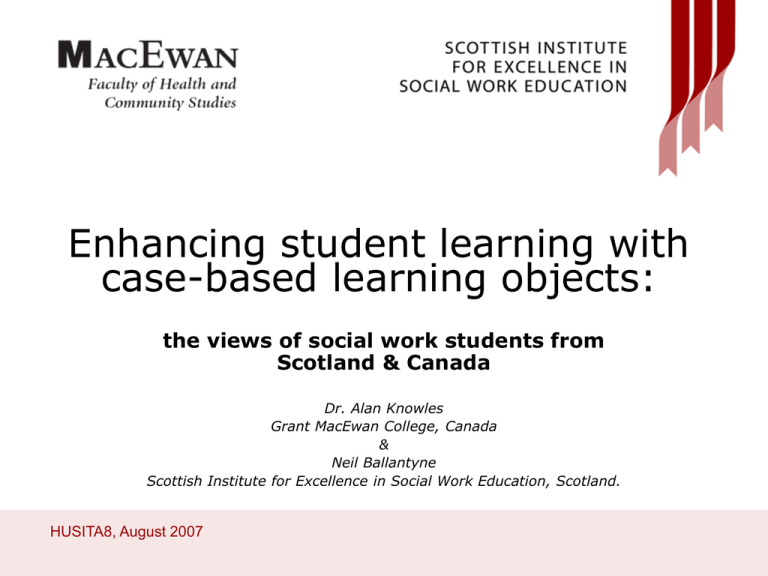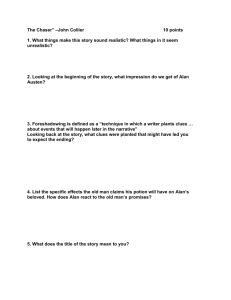sieswe-husita8-knowles-ballantyne-2007-08
advertisement

Enhancing student learning with case-based learning objects: the views of social work students from Scotland & Canada Dr. Alan Knowles Grant MacEwan College, Canada & Neil Ballantyne Scottish Institute for Excellence in Social Work Education, Scotland. HUSITA8, August 2007 Introduction • Common place use of e-Learning environments • Emergence of learning objects (LOs) and learning object repositories for content • Pedagaogical shift to constructivist approaches • Recent survey (Kim & Bonk, 2006) of online instructors’ views on the future of online learning suggested that: – blended education would become the norm; – instructors would make greater use of content in the form of learning objects; – and collaborative and problem-based learning (PBL) approaches would be used more widely Alan Knowles & Neil Ballantyne | HUSITA8, August 2007 2 of 30 Integrated learning • Problems in all programmes of professional education about perceived relevance of classroom based learning to the capabilities required of professionals in the field. • Within social work education this problem has been variously described as: – the theory/practice dilemma (Barbour, 1984); – the problem of readiness to practice (Marsh and Triseliotis, 1996); – and, more recently, the problem of integrated learning (Clapton et al, 2006). Alan Knowles & Neil Ballantyne | HUSITA8, August 2007 3 of 30 PBL as a potential solution • • • • Students learn relevant knowledge in the context of, and in order to understand authentic case situations. Didactic lectures largely, or wholly, replaced by student participation in study groups undertaking self-directed learning to resolve problems represented by questions or case material. Role of the tutor becomes that of facilitator or coach to the students’ learning. Positive reviews of the implementation of PBL in social work: – United Kingdom (Burgess & Jackson, 1990; Cree & Davidson, 2000; Downes & McCluskey, 1985; Plowright & Watkins, 2004), – Australia (Bolzan & Heycox,1997; Gibbons & Gray, 2002; Smith, 1985), – United States (Altshuler & Bosch, 2003; Sable, Larrivee & Gayer, 2001), – Hong Kong (Lam, 2004; Wong & Lam, 2007). Alan Knowles & Neil Ballantyne | HUSITA8, August 2007 4 of 30 PBL & learning technology • Some PBL instructors beginning to use computer-mediated communication (CMC) to support reflective discussions within PBL study groups in both distance & blended educational settings (Barrows, 2002; de Leng et al, 2006; Stromso et al 2007). • Others harnessing web-based multimedia to enrich the authenticity of the problem-based case material (Balslev et al, 2005; de Leng et al, 2007; Kamin et al 2003) Alan Knowles & Neil Ballantyne | HUSITA8, August 2007 5 of 30 PBL & multimedia • Potential pedagogical advantages of video based case scenarios over text-based scenarios in the context of PBL in medical education suggests that video offers – a more holistic and complex picture of the case allowing student to develop their own pattern recognition rather than relying on the preprocessed verbal descriptions of the expert tutor; – freedom for a student to observe events directly and to experience the patients or service users perspective on reality; – emotional impact conveyed through body language and subtle non-verbal and para-verbal cues supporting a more caring and empathic response from learners; – use of a medium that is more familiar to the screenagers of Generation X. de Leng (2007) Alan Knowles & Neil Ballantyne | HUSITA8, August 2007 6 of 30 Multimedia & social work education • Innovative social work educators have incorporated images, audio, and video into the curriculum to enrich and enliven teaching ever since it was possible to do so (Fredollino & Knaggs, 2005; Gelman and Tosone, 2006; Jerry and Collins, 2005; Seabury, 2003; Shibusawa et al, 2006). • However, no work in the social work literature has evaluated the use of video in a PBL context, nor have any of the materials in the studies tested the reusability of learning objects in different instructional contexts. Alan Knowles & Neil Ballantyne | HUSITA8, August 2007 7 of 30 Defining LOs “. . . the fundamental idea behind learning objects is that instructional designers can build small (relative to the size of the entire course) instructional components that can be reused a number of times in different learning contexts” (Wiley, 2000) • The concept of reusability is central Alan Knowles & Neil Ballantyne | HUSITA8, August 2007 8 of 30 The reusability paradox Pedagogical value More effective learning needs contextualisation; But increasing reusability requires less context (e.g. a single image of a genogram, versus a complete teaching unit on family systems) Potential for reuse Alan Knowles & Neil Ballantyne | HUSITA8, August 2007 Wiley (2004) 9 of 30 The reusability paradox • The solution lies in finding a ‘sweet spot’ – designing content that is large enough to be educationally meaningful yet small enough to be reusable • In the social work context, case-based learning objects may be ideal (though not the only) candidates • DEMO Alan Knowles & Neil Ballantyne | HUSITA8, August 2007 10 of 30 Research questions • Does the use of online multimedia add value to the learning experience? • In particular, does it help to make the simulated experience more authentic? • Can case-based learning objects be reused effectively in different instructional contexts? Alan Knowles & Neil Ballantyne | HUSITA8, August 2007 11 of 30 Method 1 • A questionnaire (Scottish & Canadian sample) – Opening questions included general demographic data, information related to students’ computer skills and Internet access; – A Likert-type questionnaire that included a series of 14 statements asking students to indicate the extent to which they agreed with each; – The 14 statements related to: a) orientation to the case and accessibility; b) the design of the case; and c) comparisons between learning from multimedia & text-based cases; – Included some open-ended statements. Alan Knowles & Neil Ballantyne | HUSITA8, August 2007 12 of 30 Method 2 • Focus discussion groups (Canada only) – explored students’ perspectives on authenticity, sense of immediacy and emotional reactions in using the resource, feedback on the pedagogical design of the case (problem-based learning learning design elements), and additional recommendations. Alan Knowles & Neil Ballantyne | HUSITA8, August 2007 13 of 30 Samples • Questionnaire – Group 1: Scotland – second year undergraduate students on social work law course (n=39). Study mode mainly F2F with online access as an adjunct. – Group 2: Canada – social work practice methods course (n=26). Study mode: 50% online & 50% F2F – Group 3: Canada – mental health course (n=31). Study mode: 50% online & 50% F2F – Total n=96 across all three groups • Focus groups – Two focus groups conducted with students from each of the courses in Canada (social work methods n=8; mental health and social work n=7) – Total n=15 across two focus groups Alan Knowles & Neil Ballantyne | HUSITA8, August 2007 14 of 30 Orientation & Accessibility N 1. I had technical problems accessing the multimedia case study 2. I had sufficient advice, guidance and support to help me access the case study Mean SD Canada 57 2.30 1.180 Scotland 39 2.15 .933 Canada 57 4.30 .801 Scotland 39 3.46 .969 (Likert-type scale: 1=Stongly Disagree to 5=Strongly Agree) Alan Knowles & Neil Ballantyne | HUSITA8, August 2007 15 of 30 Case study design 3. The video transcripts were very helpful 4. I thought the multimedia case study was well produced 5. Overall the performance of the actors were convincing 6. The case content seemed out of date N mean SD Canada 55 4.33 .862 Scotland 39 4.15 .670 Canada 57 4.32 .631 Scotland 39 4.23 .536 Canada 57 4.23 .756 Scotland 39 3.54 .969 Canada 57 2.32 .827 Scotland 39 1.97 .584 (Likert-type scale: 1=Stongly Disagree to 5=Strongly Agree) Alan Knowles & Neil Ballantyne | HUSITA8, August 2007 16 of 30 Comparing multimedia with text-based cases 7. Using the multimedia case study significantly enhanced my learning 8. I didn’t enjoy using the multimedia case study 9. There are no real differences learning from text-based or multimedia case studies 10. The multimedia case study increased my understanding of the complexities of practice more than the text-based case studies N Mean SD Canada 57 4.42 .755 Scotland 39 3.82 .823 Canada 56 1.89 1.039 Scotland 39 1.90 .598 Canada 57 1.81 .875 Scotland 39 1.92 .839 Canada 57 4.44 .708 Scotland 39 3.72 .916 (Likert-type scale: 1=Stongly Disagree to 5=Strongly Agree) Alan Knowles & Neil Ballantyne | HUSITA8, August 2007 17 of 30 Comparing multimedia with text-based cases (continued) 11. More of our problem-based learning should incorporate multimedia 12. The multimedia seemed more realistic than text-based case studies 13. The text-based case studies were more engaging and motivating than the multimedia case studies 14. It was easier to learn from the multimedia case than from the text-based cases N mean SD Canada 56 4.16 .890 Scotland 39 4.10 .852 Canada 57 4.35 .813 Scotland 39 4.0 1.026 Canada 56 2.21 1.246 Scotland 39 2.31 1.030 Canada 57 4.35 .790 Scotland 39 3.74 .993 (Likert-type scale: 1=Stongly Disagree to 5=Strongly Agree) Alan Knowles & Neil Ballantyne | HUSITA8, August 2007 18 of 30 Findings • The majority of students in all three settings agreed that: – the multimedia case significantly enhanced their learning; – they enjoyed using the multimedia case material; – there are differences in learning from multimedia cases as opposed to text-based cases; – the multimedia case study increased their understanding of the complexities of practice more than text based case studies; Alan Knowles & Neil Ballantyne | HUSITA8, August 2007 19 of 30 Findings (continued) – more of their PBL classes should use multimedia cases; – the multimedia case seemed more realistic than text-based cases; – text-based cases were not more engaging and motivating to learn from than multimedia – it was easier to learn from the multimedia case than the text-based cases Alan Knowles & Neil Ballantyne | HUSITA8, August 2007 20 of 30 Open-ended questions: benefits Authenticity “It helps to provide a more authentic learning experience. It also makes case scenarios more realistic and something you can identify with.” “I find that I tend to learn things more when in story formation. So to have a case study be acted out as though it were real was very beneficial.” “Brings it to life, helps you remember who the characters are and humanises them rather than words on a piece of paper.” Motivation “It is more realistic and it feels as though there is more point in helping them, which gives you more motivation to carry out the work as paper based case studies are very repetitious.” “It is more engaging. It helps make our resources more diverse and interesting.” Alan Knowles & Neil Ballantyne | HUSITA8, August 2007 21 of 30 Open ended questions: benefits Non-verbal & para-verbal communication “They bring to life scenarios allowing students to analyze body language of social workers and service users.” “Gave you the chance to see real people and body language and made the process more realistic.” “Gives an idea of thoughts and feelings as you can tune into how words are said, for example tone, pitch, speed.” Memorability “It is easier to understand and remember (the case) better.” Convenience “You can watch them over and over, therefore it helps you pick on more issues.” Alan Knowles & Neil Ballantyne | HUSITA8, August 2007 22 of 30 Open ended questions: disadvantages Technology access/failure “If technology fails then the exercise becomes pointless.” “Sometimes people cannot get access to the info which holds a lot of people up.” “Not everyone has access to computers or broadband connections.” Alan Knowles & Neil Ballantyne | HUSITA8, August 2007 23 of 30 Findings from the focus groups • the visual nature of the multimedia case was the main advantage. • convenience of being able to work through the scenarios from home,at their own pace, and replay the video scenes. • the case scenario was authentic, portrayed real emotion, and was realistic of a client situation • stronger emotional reactions and felt more involved • the actors’ expressions and non-verbal cues made the scenarios seem real - some students felt as though they were in a social worker-client relationhsip • Mixed views on amount of detailed information available/required Alan Knowles & Neil Ballantyne | HUSITA8, August 2007 24 of 30 Conclusions • Student perceptions on all three courses were consistent and positive • Multimedia case perceived as more authentic, motivating, memorable and convenient. Also appreciated access to non-verbal and para-verbal cues • Case-based LOs can be reused in different (albeit related) contexts • Therefore, value in encouraging educator collaboration & exchange • But need to design for reusability • And multimedia does not ipso facto enhance learning Alan Knowles & Neil Ballantyne | HUSITA8, August 2007 25 of 30 Limitations • Learning – Based on subjective views of students so can’t assume actual learning gains – One researcher was the instructor to the Canadian students • Reuse – Only one learning object in the study – So can’t generalise to other LOs, or different types of LOs (e.g. conceptual LOs) Alan Knowles & Neil Ballantyne | HUSITA8, August 2007 26 of 30 Future work • Reusability – Factors in the design of LOs that facilitate reuse – Factors in the embedding process that facilitate reuse • Learning – – – – Impact of multimedia on learning? Retention and recall? Role of emotion Transfer of learning? Alan Knowles & Neil Ballantyne | HUSITA8, August 2007 27 of 30 The skill of the teacher “It is not the objects that form a coherent course but the skill of the teacher in supplying a structure, a set of activities and occasional coursespecific material that act as the ‘glue’ to tie together the entire course.” Duncan (2003, p 18) Alan Knowles & Neil Ballantyne | HUSITA8, August 2007 28 of 30 For further information KnowlesA@macewan.ca & neil.ballantyne@iriss.org.uk Slides http://www.iriss.org.uk/HUSITAmultimedia Alan Knowles & Neil Ballantyne | HUSITA8, August 2007 29 of 30 Acknowledgments This project received partial funding from the MacEwan Research Council and the support of the Scottish Institute for Excellence in Social Work Education. Alan Knowles & Neil Ballantyne | HUSITA8, August 2007 30 of 30



![[#OPENDS-1029] Update daily build mail subject to indicate](http://s3.studylib.net/store/data/007734190_2-d66144ca725a9119b45ca78b6568f0a8-300x300.png)
